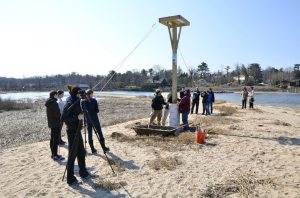 It has been a brutal winter; no more so than for all of the island’s wild creatures. For me, spring only truly begins when the osprey (our local fish hawk) returns from parts south to begin nesting. As most of us know, the osprey very often uses human-made nesting platforms; we see them scattered all along our coastline. The massive stick nests that sit atop the platform are impossible to miss; they are repaired by the osprey and built up over the years. This year, however, two of those platforms were destroyed by winter storms. Since I have been fortunate enough over the years to build and install many of those platforms, people started to call for help.
It has been a brutal winter; no more so than for all of the island’s wild creatures. For me, spring only truly begins when the osprey (our local fish hawk) returns from parts south to begin nesting. As most of us know, the osprey very often uses human-made nesting platforms; we see them scattered all along our coastline. The massive stick nests that sit atop the platform are impossible to miss; they are repaired by the osprey and built up over the years. This year, however, two of those platforms were destroyed by winter storms. Since I have been fortunate enough over the years to build and install many of those platforms, people started to call for help.
As a former science teacher in Port Washington, and as a current board member of Volunteers for Wildlife (the wildlife rescue, rehabilitation and education center located at Bailey Arboretum in Lattingtown), I know how important it is to get students involved in local environmental issues, so I contacted the Treehuggers environmental club and Zoology class at Schreiber High School. Both the teachers, Andy Apicos and Julie Barbieri, and the students were eager to get involved, and I was happy to coordinate. The results were finally finished on Thursday, April 2.
The process involved four basic steps and numerous phone calls, texts and e-mails. First, I had to get the lumber (a donor in Port was happy to contribute) and that wood had to be delivered to the high school. Second, I had to direct the students as to how to assemble to platforms (always fun with kids that do not do a great deal of manual labor). The assembled poles then had to be delivered (a very helpful local businessman donated the truck and the muscle power — the poles are 16 feet long) to Leeds Pond and Sands Point. The final, fourth step was completed on April 2 when a wonderfully energetic and enthusiastic group of students and teachers installed the platforms. As it turned out, the osprey had already arrived at both places and were eagerly awaiting the completion of our task. Now all we need to do is wait and watch to see if the birds will do their part; then spring will have truly arrived!
These students and others in the community have really made a difference!





























